As industrial networks become faster and longer, the communication performance of the RS-485 standard is approaching its limits. Engineers who use RS-485 communication in their products may be dissatisfied with the speed and distance, but are worried that "it would be too much trouble to change to another standard, so if possible, I would like to keep RS-485 and improve its functions."
This time, we will introduce the "MAX22500 series" from Analog Devices, which enables both long-distance and high-speed communication while maintaining the RS-485 standard.
The dilemma of high-speed, long-distance RS-485 transmission
The RS-485 standard has excellent noise resistance and is widely used for communication between devices in industrial networks. However, with the recent development of industrial networks, higher speeds and longer distances have become an issue.
What are the specific challenges? Initially, the RS-485 standard was developed to support a maximum data rate of 10 Mbps and a maximum communication distance of 1.2 km. However, it is not possible to achieve both at the same time. There is a trade-off between speed and distance in the RS-485 standard, and the faster the speed, the shorter the communication distance.
There is an empirical rule for this trade-off relationship, and it is known that in the general RS-485 standard, the product of data rate (bps) and distance (m) does not exceed the 8th power of 10. In other words, for transmission at 10Mbps, the distance is limited to about 10 to 15m. In recent years, RS-485 transceivers that operate at data rates of 30 to 40Mbps have appeared, but in reality they can only transmit over short distances of a few meters.
General RS485 distance and speed relationship (excerpt from Analog Devices application note [AN-960])
Meanwhile, industrial networks are becoming increasingly large and complex. The latest industrial control systems often require transmission speeds of 30 to 40 Mbps and distances of up to 100 m. Until now, it has been difficult to achieve this performance using the RS-485 standard.
Why is high-speed, long-distance transmission difficult? It is because high-speed, long-distance transmission has a negative effect on signals. Signals are affected by cables and other factors during transmission, and their quality gradually deteriorates. For this reason, if the signal is transmitted over a certain distance or more, the output waveform becomes distorted, making it difficult to read accurately. This effect becomes greater the faster the transmission is and the longer the distance is.
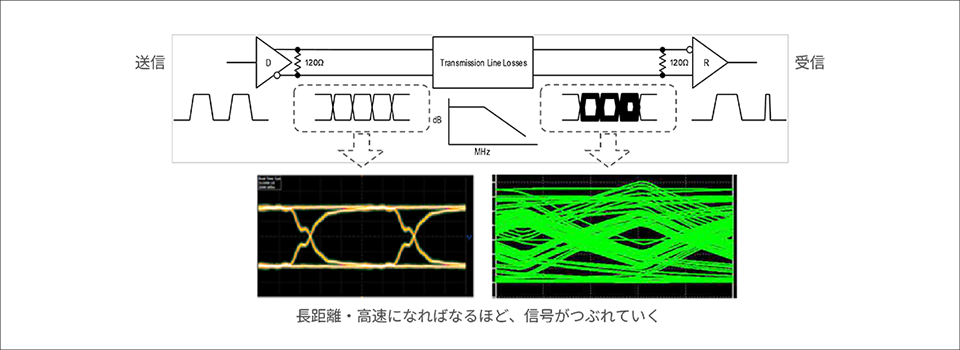
"MAX22500 Series" RS-485 transceiver that combines high speed and long distance
In this environment, the MAX22500 series RS-485 transceiver has been released, which achieves both high speed and long distance communication. It supports a maximum data rate of 100Mbps and has a CMR of ± 15V to suppress signal degradation.
If you are currently concerned about the performance of your RS-485 communications, you can improve speed and distance by simply changing your components to the MAX22500 series, without having to go to the trouble of changing the communications standard.
Of the lineup, the MAX22500E/MAX22502E operate on a 5V power supply and support the pre-emphasis function described below. The MAX22501E operates on a 3 to 5V power supply.
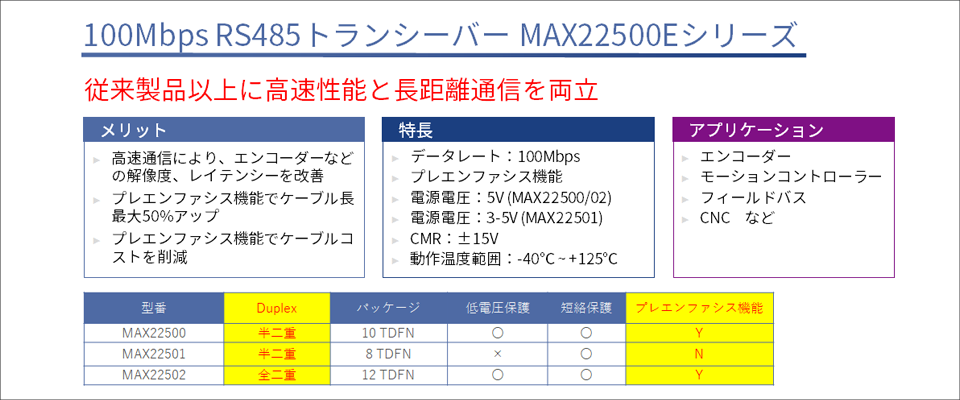
MAX22500 Series Features
The main features of the MAX22500 series are its enhanced drive capability and noise resistance. Both have been improved several times over conventional products. This makes it possible to achieve both long distance and high speed communication, which was previously difficult.
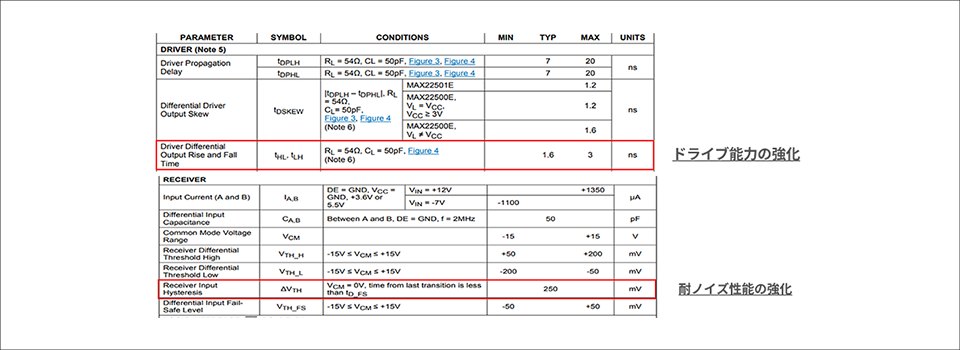
As mentioned in the previous section, the product of communication speed (bps) and distance (m) in the RS-485 standard is usually limited to about 10 to the power of 8. However, the MAX22500 series can raise this to about 10 to the power of 9. In fact, it achieves transmission performance that is about 10 times faster than conventional standards.
The figure below shows the eye diagram of MAX22500E when transmitting over 10m of Cat5e cable at a data rate of 100Mbps. The aperture height is ± 2V, ensuring high transmission quality. Compared with traditional RS-485 transceivers, the performance of the MAX22500 series is dramatically improved.
Output waveform of MAX22500E operating at 100Mbps on a 10m RS485 cable [without pre-emphasis function] (Excerpt from Analog Devices Design Solution [No. 61])
What is the pre-emphasis function?
Further performance improvement is possible with the pre-emphasis function built into the MAX22500E/MAX22502E. Pre-emphasis means to emphasize (pre) emphasis. This function prevents degradation of signal quality by emphasizing the signal before transmission. By raising the part of the waveform that would be crushed due to the influence of the cable, etc., before transmission, it is possible to minimize the deterioration of the waveform after transmission.
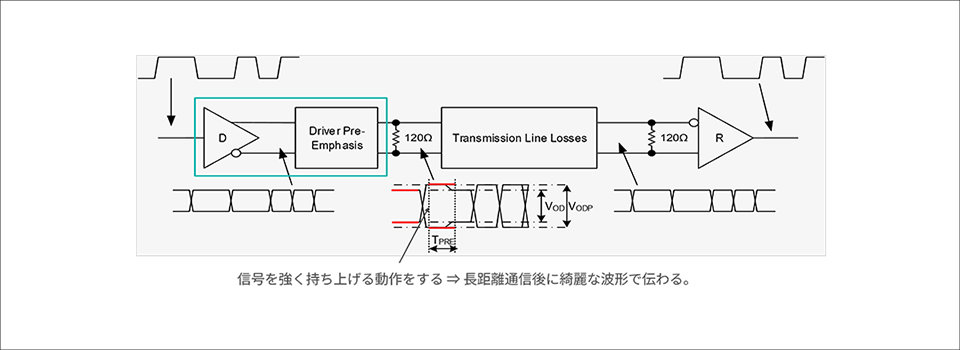
Effect of pre-emphasis function
How much can the signal waveform be improved by using the pre-emphasis function? The figure below shows an eye diagram when using the MAX22500E and transmitting a 100m Cat5e cable at a data rate of 50Mbps.
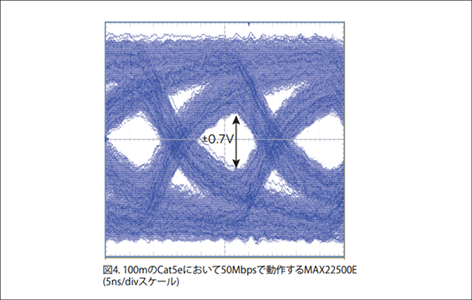
(Excerpt from Analog Devices Design Solutions [No. 61])
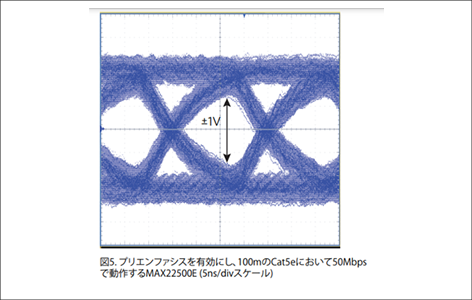
(Excerpt from Analog Devices Design Solutions [No. 61])
The left side shows the case of transmitting 50Mbps at 100m without using the pre-emphasis function. Although the aperture height ensures ± 0.7V, it can be seen that the signal quality is somewhat degraded due to the high speed and long distance transmission.
The right side shows a 50Mbps, 100m transmission with the pre-emphasis function enabled. The aperture height has been expanded to ± 1V, and the eye diagram has become clearer. It is clear that the pre-emphasis function has ensured higher transmission quality.
Relationship between communication distance and speed in the MAX22500 series
What is the relationship between communication distance and speed in the MAX22500 series? The figure below is a graph showing the relationship between communication distance and speed for the general RS-485 standard and the MAX22500E. For the MAX22500E, data is shown for both when the pre-emphasis function is disabled and enabled.
Relationship between communication distance and speed (MAX22500 data)
Excerpt from Analog Devices' document library [Pre-Emphasis Improves RS-485 Communications]
As can be seen, even with pre-emphasis disabled, the MAX22500 series outperforms the traditional RS-485 standard by a large margin, delivering much faster data rates over the same distance.
As the transmission distance increases, the maximum data rate decreases, but this decrease can be mitigated by enabling the pre-emphasis function, making it possible to achieve even higher speeds and longer distances.
When using the pre-emphasis function, the device you are communicating with must also have a pre-emphasis function. If this is not the case, you can disable the pre-emphasis function. In addition, we also offer a lineup without the pre-emphasis function (MAX22501E). You can select the lineup that best suits your application.
This time, we introduced the MAX22500 series from Analog Devices, which achieves both long-distance and high-speed communication of the RS-485 standard. By using the MAX22500 series, you can significantly improve the communication performance of RS-485 simply by changing the parts. There is an evaluation board, so please try it out.
If you are interested, please feel free to contact us.
Click here to purchase products
Click here for manufacturer site/other related links
- MAX22500E (Various data can be downloaded here)
- Pre-Emphasis Improves RS-485 Communications
- RS-485: Overcoming the Speed vs. Distance Trade-Off Challenge (Analog Devices Design Solutions [No. 61])
- RS-485/RS-422 Circuit Implementation Guide (Analog Devices application note [AN-960])
- EMC Surge Protection Level 4, Fully Tested and Certified RS-485 Transceiver ADM2795E
- ADM3065E ESD Hardened RS485 Device
- What is the difference between RS-232/422/485 standards? Serial communication and industrial networks
- Latest information on industrial network types and market share [Is RS485 outdated?]
Inquiry
If you have any questions regarding this article, please contact us below.
Analog Devices Manufacturer Information Top
To return to the Analog Devices manufacturer information top page, please click below.
